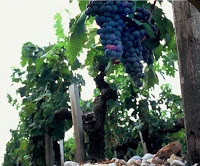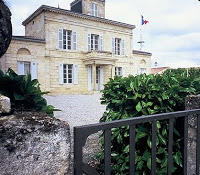La Dame de Montrose is the Second  Wine of Chateau Montrose and is named after Yvonne Charmolüe who ran the estate from 1944 to 1960. Montrose lies in the east of Saint Estèphe, just north of the hamlet of Marbuzet, on a gravel knoll only 800 metres from the Gironde estuary.
Wine of Chateau Montrose and is named after Yvonne Charmolüe who ran the estate from 1944 to 1960. Montrose lies in the east of Saint Estèphe, just north of the hamlet of Marbuzet, on a gravel knoll only 800 metres from the Gironde estuary.
Château Montrose began life when Etienne-Théodore Dumoulin purchased the gravel ridge in 1778 from Alexandre de Ségur (who owned vast swathes of vineyard in the Northern Médoc and gave his name to several properties such as Château Calon Ségur).
Dumoulin’s son saw the potential for wine making in the heather covered slopes of the moor named La Lande de l’Escargeon, cleared the scrub and planted his vineyard.
He built Château Montrose in 1815, named after the pink haze of heather that had once covered the gravelly knoll. Dumoulin’s unrelenting passion drove him to expand this vineyard, selling off other parts of the estate. By 1825 there were 12-15 acres of vines, and by 1832 the estate had been increased to 85 acres.
In 1855 Château Montrose was classified among the  Second Growths of the Médoc. Nowadays the vineyard is 160 acres and the grapes growing there are 65% Cabernet Sauvignon, 25% Merlot, 8% Cabernet Franc and 2% Petit Verdot.
Second Growths of the Médoc. Nowadays the vineyard is 160 acres and the grapes growing there are 65% Cabernet Sauvignon, 25% Merlot, 8% Cabernet Franc and 2% Petit Verdot.
After Dumoulin’s death Château Montrose was sold to another enlightened man – Mathieu Dollfus. Dollfus built the estate into a thriving community, offering profit sharing and health care to his employees – an unusual act for those times.
His heirs sold Château Montrose to the owners of Cos d’Estournel and it then passed on to Louis Victor Charmolüe – where it has remained for over 100 years until recently. In 2006 ownership passed to Martin and Oliver Bouygues who employed Jean-Bernard Del mas, once the wine maker at Château Haut Brion.
mas, once the wine maker at Château Haut Brion.
When Louis Victor Charmolüe died in 1925 he bequeathed the estate to his son Albe who married Yvonne Laure Jeanne Decaze, his second cousin, just one month after his father’s death.
Albe had fought in the First World War and survived Verdun but sadly he had also been gassed, which damaged his future health. He steered Montrose through the Crash and the Great Depression. A lot of the buildings were destroyed by fire in 1933.
Then came the Second World War. Albe tried to go to war again but was soon demobbed. The French Army installed anti–aircraft guns on the property and commandeered most of the Chateau. When the German forces took Montrose it was used as an artillery base, and the vineyards made a handsome firing range, suffering some bomb damage.
bomb damage.
Throughout this awful period, Albe courageously continued to make fine wine, but had to reduce the vineyard area and the production.
Albe and Yvonne had a son, Louis, in 1926. Then, in 1929, a daughter Francoise. In 1933, tragically, Louis died, aged just 8 years.
In 1935, more happily, Jean–Louis was born. In 1944, Albe died suddenly and prematurely. His health had been poorly ever since the gas in the First World War.
Jean–Louis was only 9 years old. For 16 years Yvonne brought up the young children and struggled to look after the property through difficult times. Under her care Montrose started to regain its strength and having only produced 25 tonneaux in 1943 was now producing anything from 80–130.
anything from 80–130.
In 1960 Yvonne Charmolüe passed Montrose on to Jean–Louis and he took on the task of restoring the Château to its former glory. Indeed, he even surpassed it. He introduced new equipment, a new cellar and introduced the Second Wine in 1983 – La Dame de Montrose – named for his mother.
Yvonne Charmolüe sowed the seeds for Montrose’s renaissance, and Jean-Louis let them bloom – which has resulted in some highly lauded wines, the 1990, 2003 and now the 2009 receiving 100 point scores from Robert Parker.
La Dame de Montrose 2009 has the highest score from Parker it has achieved to date which is 91 – 93. It is as yet the best La Dame de Montrose made and is a fitting tribute to the lady who helped steer the estate through such hard pressed times.


